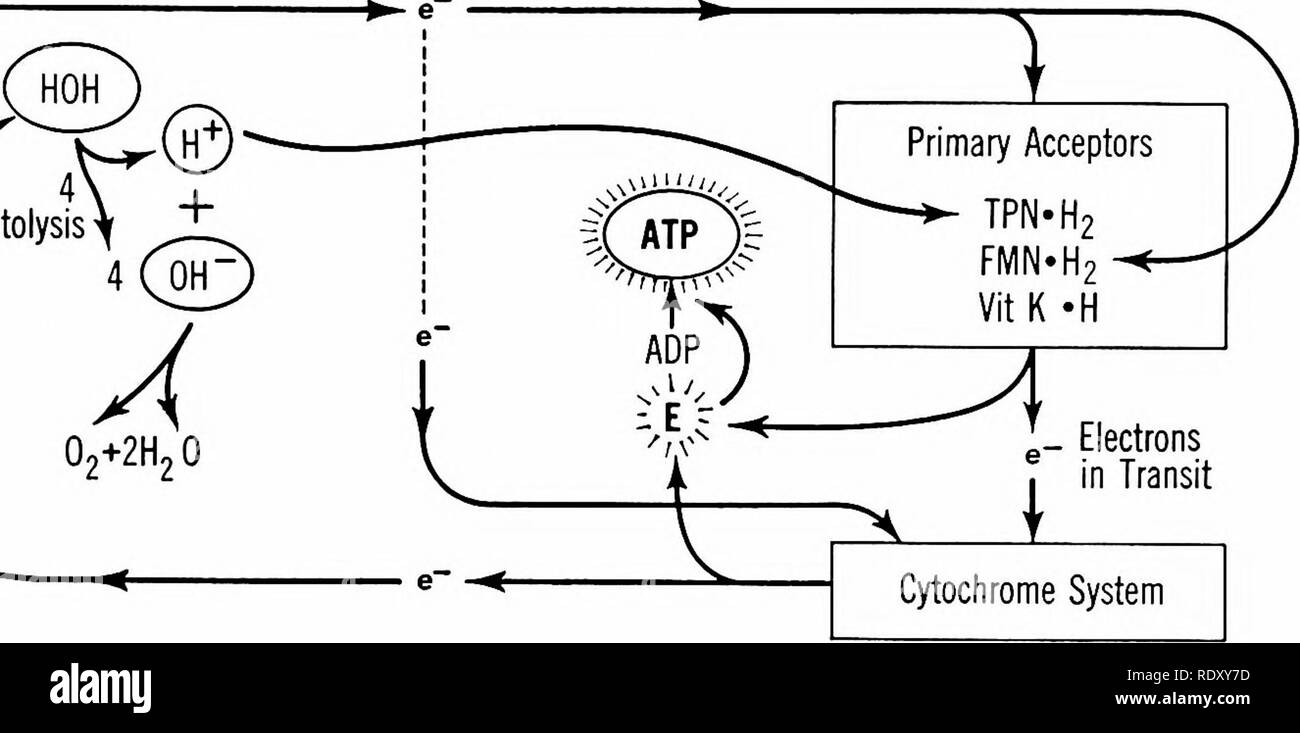. Principles of modern biology. Biology. Nutrition of Green Planf Cells - 163 Light Energy (Photons) Chloroplast Electrons Returning 4^ Photolysis 4 (OH Photon- Excited Electrons -*e. Fig. 9-4. In the chloroplasts, light energy is transformed into the chemical potential energy that is stored, mainly, as ATP, TPNH2, and FMN-H.,. Note that some of the electrons, after escaping from light-excited chlo- rophyll, finally return to chlorophyll, forming a cycle. Simplified schema, after Arnon. excited elections, ejected from chlorophyll, keep returning to the chlorophyll, having discharged their e

Image details
Contributor:
The Book Worm / Alamy Stock PhotoImage ID:
RDXY7DFile size:
7.1 MB (190.1 KB Compressed download)Releases:
Model - no | Property - noDo I need a release?Dimensions:
2247 x 1112 px | 38 x 18.8 cm | 15 x 7.4 inches | 150dpiMore information:
This image is a public domain image, which means either that copyright has expired in the image or the copyright holder has waived their copyright. Alamy charges you a fee for access to the high resolution copy of the image.
This image could have imperfections as it’s either historical or reportage.
. Principles of modern biology. Biology. Nutrition of Green Planf Cells - 163 Light Energy (Photons) Chloroplast Electrons Returning 4^ Photolysis 4 (OH Photon- Excited Electrons -*~e. Fig. 9-4. In the chloroplasts, light energy is transformed into the chemical potential energy that is stored, mainly, as ATP, TPNH2, and FMN-H., . Note that some of the electrons, after escaping from light-excited chlo- rophyll, finally return to chlorophyll, forming a cycle. Simplified schema, after Arnon. excited elections, ejected from chlorophyll, keep returning to the chlorophyll, having discharged their energy in the generating of two new high-energy phosphates (ATP). For noncyclic phosphorylation to occur, in contrast, TPN must be added to the medium in which the isolated chloroplasts are operat- ing. This compound, having received elec- trons from chlorophyll (Fig. 9-4), can now act as an acceptor of H+ ion (from water), in which case TPN-H2 tends to accumulate in the medium. But the electrons that flow back to the chlorophyll via the cytochrome system are derived from OH- ions, as is shown in Figure 9-4. Thus the flow of electrons is not cyclic. However, each electron, as it flows through the cytochrome system, generates energy for "charging up" one more molecule of ATP. Certain bacteria, utilizing pigments other than chlorophyll, can draw upon light as the source for building up their reserves of chem- ical potential energy. These more primitive photochemical systems are important in rela- tion to the evolution of plant life and they will be considered briefly later (p. 187) in that connection. Dark Reactions: Assimilation COo. As cur- rently conceived, the net effect of light energy, operating through mechanisms within the chloroplast, is to build up the cellular reserves of certain energy-rich molecules, par- ticularly ATP and TPN-H, . Moreover, it is now known that even isolated chloroplasts can continue to utilize C02 for the synthesis of glucose and other comp